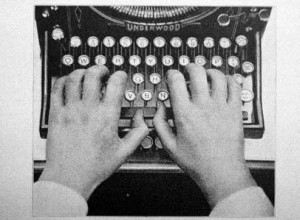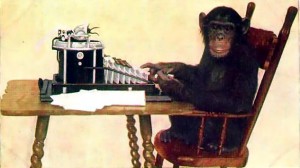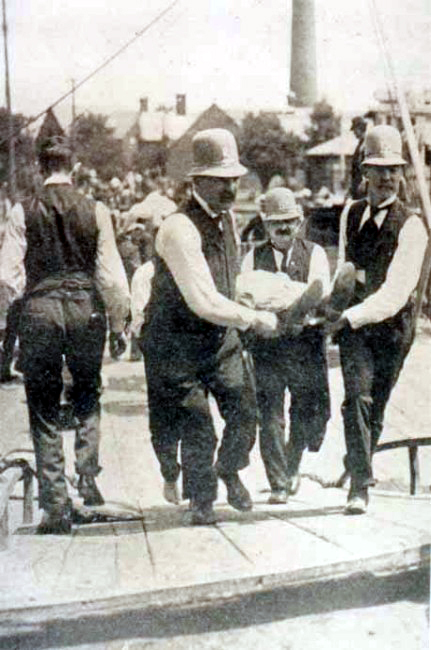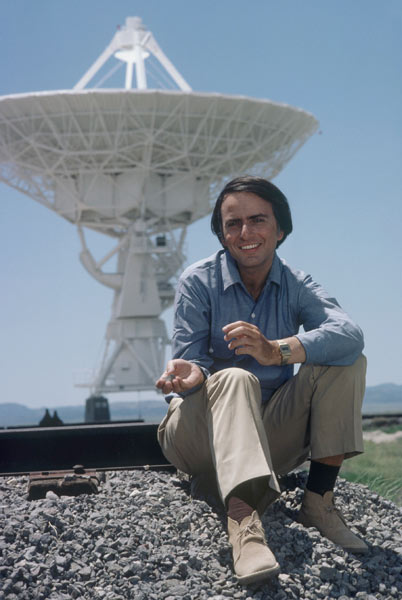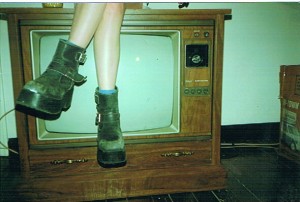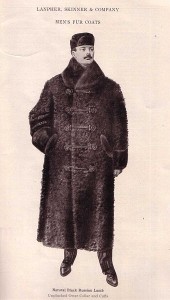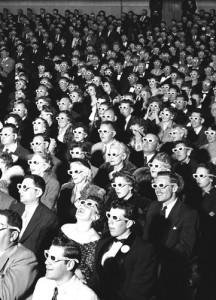In 1979, only 12 people at a time were able to use mobile phones in New York City. But in Chicago an experiment was under way.
You are currently browsing the yearly archive for 2011.
Some search-engine keyphrases bringing traffic to Afflictor this week:

Afflictor: Celebrating the Fourth of July with the most perverted-looking Uncle Sam on Earth, since 2009.
- Recent Films: Somewhere + Another Year.
- Old Print Articles: Oystermen and their troubles (1887) + British-born burglar plies his trade in NYC (1901) + Everyone dresses like a baby at a D.C. party (1912).
- Classic Photograph: Carrying the dead from the General Slocumb (1904).
- Featured Videos: Hospital etiquette for clowns + Norman Mailer and feminists meet in Manhattan (1971) + Chimpanzee playing violent video games + BBC interview with J.R.R. Tolkien + Robot that shoots pool + Russian trash television + Dan Sandin, computer graphics hippie + Coke’s Bicentennial TV commercial + Foam letters float over Germany.
- Recently Posted on NYC’s Craigslist: I am a horrible person who judges everyone’s appearance on the subway + Who’s that chick with the studs in her neck? + I think someone will buy my insane screenplay + Willing to take your porno, even the really bad stuff that you should not even have + Looking to buy some old-fashioned underwear + Working typewriter wanted.
- Catching up with Renée Richards 35 years after she rocked the tennis world.
- A 1982 New York Times article that accurately predicted the digital revolution.
- Jonathan Franzen complains about cell phones.
- In 1961, the Bowery mourned a movie theater ticket seller named Mazie.
- The inventor of Sea-Monkeys had ties to Aryan supremacists.
- A 1958 New Yorker profile of fashion photographer Richard Avedon.
- Do ATM machines use sound effects?
- Chuck Close discusses his work on local NYC television in 1978.
- MIT is building mind-control helmets for mice.
- Looking back at the 1995 Tokyo subway terrorists.
- Movie-theater chains trying out a Netflix pay model.
- Youth Culture hits the skids in 1971.
- Peter Falk and friends talk to Dick Cavett in 1970.
- An 1893 map that depicts the Earth as square and stationary.
- Carl Sagan was a big pothead for about 45 years.
- Homo Erectus was an imbecile who repeatedly made the same mistakes.
- David Foster Wallace looks at the nexus of literature and television in 1993.
- The Wild West stage shows that presaged Hollywood.
- Afflictor Nation: Crowning a champion in June.
- This week’s Afflictor keyphrase searches.

"A screwball comedy featuring a transsexual, a gorilla, two drag queens, a Metro-sexual, and a Slovenian actress with penis envy."
Screenplay Option For Sale – $2000 (Midtown)
I am looking to sell an option to the following screenplay for $2,000. It is a briskly-paced 102 pages and can be produced very cheaply. This option would apply to all media, worldwide, in perpetuity. If interested, please send an email and I’ll send along the script, and if you like it we’ll work out our agreement from there. Only SERIOUS inquiries, please. Am looking for someone who reads and moves quickly so that other prospects are not kept waiting. Thank you and I look forward to being in touch.
REPLY ALL
A screwball comedy featuring a transsexual, a gorilla, two drag queens, a Metro-sexual, and a Slovenian actress with penis envy.
Many of us have, at some point or another, had the horrible experience of writing an intimate email, hitting the “reply all” button by accident, and ended up sharing our thoughts with half the world. Now three unfortunate individuals are about to learn what happens after hitting that dreaded button. A hotshot lawyer and ladies man accidentally reveals to the entire office that he likes getting manicures. A teenage girl ends up telling the entire faculty that she thinks her teacher is effeminate. And an event organizer reveals to everyone that she thinks her boss is a criminal…which may turn out to be true.
Reply All is a madcap comedy in the style of The Hangover, A Fish Called Wanda, and My Cousin Vinny.
Coke’s Bicentennial year ad.
It’s easy to dismiss Sofia Coppola’s work as thin dilettantism, with the plotting generally so spare and the characters so often rich and idle. But it’s unfair and lazy to do so, especially in the case of Somewhere, a gorgeous sliver of a film that almost operates as a poem.
Johnny Marco (Stephen Dorff) is your average Hollywood star, turning out diverting formula films in between an endless summer of casinos, strippers and substances. He’s living hard and looking bad, having checked in for a stay of indeterminate length at the Chateau Marmont. The only semblance of normalcy in his life is his relationship with his 11-year-old daughter, Cleo (Elle Fanning), who lives with her mom. Cleo is clearly the child of wealth, indulged with endless classes that make her expert at an impressive number of things, but she’s living an exciting life at a time when a stable one would be preferable.
 When mom flakes out, Johnny gets full custody of Cleo until summer camp is to start. He’s only half-prepared for the task, providing for Cleo a mix of sweet underwater tea parties and quality time at craps tables. Cleo gets to see too much of the adult world and Johnny gets to see that he’s still really a child.
When mom flakes out, Johnny gets full custody of Cleo until summer camp is to start. He’s only half-prepared for the task, providing for Cleo a mix of sweet underwater tea parties and quality time at craps tables. Cleo gets to see too much of the adult world and Johnny gets to see that he’s still really a child.
Coppola is so unusually observant and has such a unique way of creating milieu and communicating her feelings that all her movies are very personally hers. Her characters are often self-pitying and sometimes pitiable, but Coppola knows a secret: All people are exotic, not for the trappings of their lives but because of the traps they fall into. In Somewhere, she consistently reveals that knowledge with deceptive ease.•
Recent Film Posts:
- Recent Film: Another Year
- Classic Film: The Truman Show (1996)
- Classic Film: Salesman (1968)
- Classic Film: Night of the Living Dead (1968)
- Classic Film: The Conversation (1974)
- Classic Film: King of Comedy (1982)
- Recent Film: Dogtooth
- Classic Film: RoboCop (1987)
- Recent Film: Marwencol (2010)
- Classic Film: Being There (1979)
- Classic Film: Woman in the Dunes (1964)
- Classic Film: The Man in the White Suit (1951)
- Classic Film: Smile (1975)
- Classic Film: 8 1/2 (1963)
- Classic Film: Zelig (1983)
- Classic Film: Fahrenheit 451 (1966)
- Recent Film: Waste Land.
- Classic Film: Westworld (1973)
- Classic Film: F for Fake (1974)
- Strange, Small & Forgotten Films: Little Murders (1971)
- Classic Film: The Passenger (1975)
- Classic Film: The Man Who Fell to Earth (1976)
- Classic Film: Fast, Cheap & Out of Control (1997)
- Strange, Small & Forgotten Films: Decasia: The State of Decay (2002)
Tags: Elle Fanning, Sofia Coppola, Stephen Dorff
Dan Sandin, computer pioneer, doing his magic in 1973. (Thanks Reddit.)
Tags: Dan Sandin
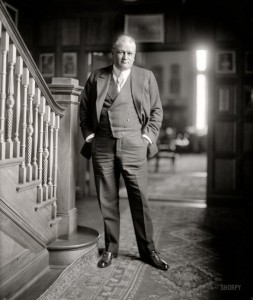
"The honors of the evening went to the 200-pound brother-in-law of the young hostess, Joseph Leiter, who appeared in a fascinating little frock modeled after those work by his own two-year-old son."
This one is just odd. In 1912, President Taft’s daughter, Helen, was honored with a slew of society parties in Washington D.C. In order to break up the monotony, everyone was asked to dress like babies at one gathering, including 200-pound wheat speculator Joe Leiter, as the New York Times dutifully noted in its February 18, 1912 issue. An excerpt:
“The cry of textile manufacturers that more material be used in the fashionable frocks of the coming season has been heeded by at least one of Washington’s social leaders, as shown by a recent dinner party in honor of Miss Helen Taft at the home of Col. and Mrs. John R. Williams.
To vary the monotony of the six nights in a week programme that has been offered the President’s daughter all Winter, Miss Dorothy Williams, daughter of the hosts, conceived the idea of making this occasion unique, and requested her friends to make this a baby party, the babies to range from the cradle to the kindergarten class.
The honors of the evening went to the 200-pound brother-in-law of the young hostess, Joseph Leiter, who appeared in a fascinating little frock modeled after those work by his own two-year-old son, but containing something like two pieces of French muslin, five times the usual number of pieces of valenciennes lace and insertion, and nobody knows how many bolts of baby ribbon.
The entire costume, which was complete in every detail from the shoulder knots to the bows on his shoes, was furnished to order and fitted with care by one of the society modistes whose ‘children’s clothes’ have made her a reputation as a business woman as enviable as that she formerly enjoyed as a Washington belle in the navy circle.”
More posts about strange social gatherings:
Tags: Helen Taft, Joe Leiter, William Howard Taft
Great Britain retained its claim as Afflictor Nation champion in June, sending more unique visitors to this site than any other foreign country. Here are the top five finishers:
- Great Britain
- Canada
- Australia
- Germany
- Netherlands
Tags: Pippa
 I’m happy people use cell phones and BlackBerrys non-stop. It distracts them the way shiny necklaces distract monkeys, and they have less time to try to stab me in the head with a box cutter. But Jonathan Franzen isn’t so sanguine about the intrusion of cell phones into public space. From his new essay (free registration required) on the topic in Technology Review:
I’m happy people use cell phones and BlackBerrys non-stop. It distracts them the way shiny necklaces distract monkeys, and they have less time to try to stab me in the head with a box cutter. But Jonathan Franzen isn’t so sanguine about the intrusion of cell phones into public space. From his new essay (free registration required) on the topic in Technology Review:
“The technological development that has done lasting harm of real social significance–the development that, despite the continuing harm it does, you risk ridicule if you publicly complain about today–is the cell phone.
Just 10 years ago, New York City (where I live) still abounded with collectively maintained public spaces in which citizens demonstrated respect for their community by not inflicting their banal bedroom lives on it. The world 10 years ago was not yet fully conquered by yak. It was still possible to see the use of Nokias as an ostentation or an affectation of the affluent. Or, more generously, as an affliction or a disability or a crutch. There was unfolding, after all, in New York in the late 1990s, a seamless citywide transition from nicotine culture to cellular culture. One day the lump in the shirt pocket was Marlboros, the next day it was Motorola. One day the vulnerably unaccompanied pretty girl was occupying her hands and mouth and attention with a cigarette, the next day she was occupying them with a very important conversation with a person who wasn’t you. One day a crowd gathered around the first kid on the playground with a pack of Kools, the next day around the first kid with a color screen. One day travelers were clicking lighters the second they were off an airplane, the next day they were speed-dialing. Pack-a-day habits became hundred-dollar monthly Verizon bills. Smoke pollution became sonic pollution. Although the irritant changed overnight, the suffering of a self-restrained majority at the hands of a compulsive minority, in restaurants and airports and other public spaces, remained eerily constant. Back in 1998, not long after I’d quit cigarettes, I would sit on the subway and watch other riders nervously folding and unfolding phones, or nibbling on the teatlike antennae that all the phones then had, or just quietly clutching their devices like a mother’s hand, and I would feel something close to sorry for them. It still seemed to me an open question how far the trend would go: whether New York truly wanted to become a city of phone addicts sleepwalking down the sidewalks in icky little clouds of private life, or whether the notion of a more restrained public self might somehow prevail.
Needless to say, there wasn’t any contest. The cell phone wasn’t one of those modern developments, like Ritalin or oversized umbrellas, for which significant pockets of civilian resistance hearteningly persist. Its triumph was swift and total. Its abuses were lamented and bitched about in essays and columns and letters to various editors, and then lamented and bitched about more trenchantly when the abuses seemed only to be getting worse, but that was the end of it. The complaints had been registered, some small token adjustments had been made (the ‘quiet car’ on Amtrak trains; discreet little signs poignantly pleading for restraint in restaurants and gyms), and cellular technology was then free to continue doing its damage without fear of further criticism, because further criticism would be unfresh and uncool.”
Tags: Jonathan Franzen
Working Typewriter Wanted (ANY)
I am looking for a working typewriter and ribbon. Any help is appreciated. Thank you. Please call if you have one.
The greatest loss of life in the New York City area prior to September 11th was caused by the 1906 disaster of the General Slocum, a steamer carrying approximately 1400 souls to a Sunday school picnic on Long Island. The classic photo above shows the aftermath of a fire, which began somehow in the Lamp Room, creating a conflagration which soon engulfed the ship. More than 1000 people perished. The last survivor of the calamity was Adella Wotherspoon, a baby at the time who lived to see her hundredth birthday. An excerpt from her 2004 New York Times obituary:
“On June 15, 1904, a sunny Wednesday morning, Mrs. Wotherspoon, then the 6-month-old called Adele Liebenow, was part of the 17th annual Sunday school picnic of St. Mark’s Evangelical Lutheran Church, on the heavily German Lower East Side. The church had chartered a paddle-wheel, 264-foot-long steamboat, for $350 from the Knickerbocker Steamboat Company to go to Locust Grove Picnic Ground at Eaton’s Neck on Long Island.
The Liebenow party included Adele’s parents, her two sisters, three aunts, an uncle and two cousins. When the boat left the East River pier at Third Street at 9:40 a.m., a church band on board played, ‘A Mighty Fortress Is Our God.’
Forty minutes later, the joy turned to abject terror. Smoke started billowing from a forward storage room. A spark, most likely from a carelessly tossed match, had ignited some straw. Soon, the boat was an inferno. The captain ignored cries to steam for shore and proceeded at top speed through the perilous waters known as Hell Gate to North Brother Island, a mile ahead.
The inexperienced crew, which had not had a single fire drill, provided scant help. Lifeboats were wired or glued to the deck with layers of paint, cork in the life jackets had turned to dust with age and fire hoses broke under water pressure.
By the time the General Slocum reached the island, it was too late. The death toll among the estimated 1,331 passengers was 1,021, according to most sources. The dead included Adele’s sisters, Anna, 3, and Helen, 6. Munsey’s Magazine, a periodical of the time, wrote, ‘Children whom the flames had caught on the forward decks rushed, blazing like torches to their mothers.'”
Tags: Adele Liebenow, Adella Wotherspoon
In “Mr. X,” an article written in 1969 and published two years later, Carl Sagan wrote about his use of marijuana, which apparently was a part of his life for more than four decades. The opening:
It all began about ten years ago. I had reached a considerably more relaxed period in my life – a time when I had come to feel that there was more to living than science, a time of awakening of my social consciousness and amiability, a time when I was open to new experiences. I had become friendly with a group of people who occasionally smoked cannabis, irregularly, but with evident pleasure. Initially I was unwilling to partake, but the apparent euphoria that cannabis produced and the fact that there was no physiological addiction to the plant eventually persuaded me to try. My initial experiences were entirely disappointing; there was no effect at all, and I began to entertain a variety of hypotheses about cannabis being a placebo which worked by expectation and hyperventilation rather than by chemistry. After about five or six unsuccessful attempts, however, it happened. I was lying on my back in a friend’s living room idly examining the pattern of shadows on the ceiling cast by a potted plant (not cannabis!). I suddenly realized that I was examining an intricately detailed miniature Volkswagen, distinctly outlined by the shadows. I was very skeptical at this perception, and tried to find inconsistencies between Volkswagens and what I viewed on the ceiling. But it was all there, down to hubcaps, license plate, chrome, and even the small handle used for opening the trunk. When I closed my eyes, I was stunned to find that there was a movie going on the inside of my eyelids. Flash . . . a simple country scene with red farmhouse, a blue sky, white clouds, yellow path meandering over green hills to the horizon. . . Flash . . . same scene, orange house, brown sky, red clouds, yellow path, violet fields . . . Flash . . . Flash . . . Flash. The flashes came about once a heartbeat. Each flash brought the same simple scene into view, but each time with a different set of colors . . . exquisitely deep hues, and astonishingly harmonious in their juxtaposition. Since then I have smoked occasionally and enjoyed it thoroughly. It amplifies torpid sensibilities and produces what to me are even more interesting effects, as I will explain shortly.•
Tags: Carl Sagan
Let’s hope the following statement about TV from the 1993 David Foster Wallace essay, “E Unibus Pluram: Television and U.S. Fiction,” isn’t true anymore. Perhaps the marginalization of TV in a multi-platform media world has made programmers more desperate, more willing to give us bread and circuses in a desperate attempt to attract viewers. But what if it still is true? What then?
••••••••••
“If we want to know what American normality is – what Americans want to regard as normal – we can trust television. For television’s whole raison is reflecting what people want to see. It’s a mirror. Not the Stendhalian mirror reflecting the blue sky and mud puddle. More like the overlit bathroom mirror before which the teenager monitors his biceps and determines his better profile. This kind of window on nervous American self-perception is just invaluable, fictionwise. And writers can have faith in television. There is a lot of money at stake, after all; and television retains the best demographers applied social science has to offer, and these researchers can determine precisely what Americans in 1990 are, want, see: what we as Audience want to see ourselves as. Television, from the surface on down, is about desire. Fictionally speaking, desire is the sugar in human food.”
••••••••••
Tags: David Foster Wallace
Death by clowning is now the third leading killer of Americans, trailing only brain fat and monkey bites. (Thanks Found Footage Festival.)
MIT is building mind-control helmets for mice, hoping to eventually have domain over brain functions in humans in order to control disease. An excerpt from a Discover article:
“Christian Wentz from MIT has designed a hat that wouldn’t look out of place at a horse race or a royal wedding. It consists of two circuit boards and an antenna, and it’s being modelled by a mouse. Wentz has wired the hat directly to the mouse’s brain and he can use it to control the animal’s behaviour with flashes of light. And most importantly, he can do it from afar.
The wireless helmet is the latest innovation in the exciting field of optogenetics, where scientists can use light to control the behaviour of both cells and entire animals. The typical set up involves loading cells – usually neurons – with a light-sensitive gatekeeper protein. When the protein sees the light, it opens up and allows ions to enter the neuron, making it fire.
By introducing the proteins into the right spot, scientists can switch on specific parts of the brain, or even individual neurons. They can turn on aggressive or sexual behaviour or make animals walk in circles. The technique promises to revolutionise our understanding of the way the brain works. It could even help to develop treatments for diseases.”
Tags: Christian Wentz
Springer, Russian-style. Kick to bride’s stomach early. (Thanks Reddit.)
The tennis player Renée Richards caused a sensation in 1976 when she revealed that she had been born a man and undergone a sex-change operation. She was quickly lambasted by critics who thought she had an unfair advantage over her female opponents, but it seemed like an excuse to unload on someone who made much of America uncomfortable. Michael Weinreb of Grantland has a smart new interview with Richards, who is today a septuagenarian Manhattan opthamologist conflicted about being a public figure. An excerpt:
“‘No, no, no, no,’ she says now, at age 76, sitting in her cozy examining room. Her voice is a rasp; her sweater is pink. She is surrounded by autographed photos of Martina Navratilova and Virginia Wade. ‘That was not my intention. It’s not so much the idea that I wanted to be a pioneer and a standard-bearer. It was a much more selfish reason. I’d gone through such an upheaval in my life, and they’re telling me I can’t play tennis? Suddenly I said to myself, ‘I can do anything any other woman is entitled to do. How dare they?’
‘I was a quiet person. I mean, I’m not a shrinking violet, but I was a very private person. I was very well-liked, and I was very well-respected. And a lot of that was thrown away because I became a caricature, a public notorious figure. I was undressed in front of the world.'”
••••••••••
A new documentary about Richards:
The opening of the September 6, 1976 Sports Illustrated article about the Richards revelation: “At first, it seemed like a put-on. A transsexual tennis player? A 6’2” former football end in frilly panties and gold hoop earrings pounding serves past defenseless girls? A 42-year-old Yale graduate, Navy veteran, devoted father and respected eye surgeon reaching the semifinals of the $60,000 Tennis Week Open in South Orange, N.J. and demanding to play in the U.S. Open at Forest Hills? In women’s singles? Who ever heard of such a thing?
In the past month, practically everyone. And certainly last week there was no escaping the extraordinary spectacle of Renee Richards, nee Richard Raskind, and her assertion that ‘anatomically, functionally, socially, emotionally and legally I am a female.’ While conceding that her action might be ‘mind-boggling,’ Richards proclaims that she is embarked on a crusade for human rights, a quest ‘to prove that transsexuals as well as other persons who are fighting social stigmas can hold their heads up high.’
If tennis seems a rather fragile or inappropriate vehicle for carrying such a weighty message, it nonetheless provides, as Richards is well aware, the kind of exposure that attracts disciples. After one match last week, Dr. Roberto Granato, the urologist who performed the ‘sex-reassignment operation’ on Richards a year ago, rushed onto the court, embraced his former patient and exclaimed, ‘Oh, Renee, this is going to help so many people!’
Not everyone is so enthralled.”
Tags: Michael Weinreb, Renée Richards
Howard Anderson, a.k.a. Andrew Andrews, was a fin-de-siècle British-born burglar run amok in New York City, a second-story man with sticky fingers and a ready alibi. He resolutely lived the grifter’s life, as the following story from the January 10, 1901 Brooklyn Daily Eagle illustrates. An excerpt:
“Howard Anderson, alias Andrew Andrews, 44 years old, said by the police to be an English crook, was arraigned before Magistrate Meade in the Harlem Police Court to-day as a suspicious person. At 1 o’clock this morning Policeman Powers of the East One Hundred and Twenty-sixth street and Third Avenue with a bundle. Powers asked the man what he had. Anderson said that he was a purchaser of pawnbroker’s tickets and had just takent something out of a pawn.
Powers took the man to the station and the bundle was found to contain a coat trimmed with Persian lamb’s wool and two shot guns. The Sergeant happened to have at the station a police alarm relative to the burglary of the summer home of Charles W. Dickel, who keeps a riding school in Fifty-sixth street, between Sixth and Seventh Avenues, and who has his summer home at Scarsdale, which is just beyonmd White Plains.
On the night of January 2 last Dickel was awakened by hearing some one move about the house. He went through the house and scared the burglar off, but he had gotten away with the coat and two shotguns.
 So soon as the articles were identified Chief of Police Carpenter of White Plains was notified and he came to this city. He was in court when Anderson was arraigned.
So soon as the articles were identified Chief of Police Carpenter of White Plains was notified and he came to this city. He was in court when Anderson was arraigned.
Detective Frank Prince, who was in court identified Anderson as Howard Andrews, a well known English crook and worker of suburban houses and second story thief . Detective Prince said he had served six and a half years of a ten years’ sentence for stealing $10,000 worth of silverware from a millionaire’s residence in Hmepstead, L.I.
Magistrate Meade dismissed the case against Anderson and turned him over to Chief Carpenter of White Plains, warning Caroenter to look out and not let him go.”
In addition to the elimination of late fees and a long-tail inventory, Netflix was a category killer for video stores because it offered a flat-fee buffet-style arrangement. Yes, there was “toggling” that delayed the heaviest users from seeing the most desirable movies first, but you got quantity and quality for your money. In a new Wired.com article, Angela Watercutter looks at how theater chains are introducing a similar model to try to increase profits:
“MoviePass, a new $50-per-month service for film fans, will let subscribers watch unlimited movies in theaters using their smartphones as tickets.
Using an HTML5 application (native smartphone apps coming soon), MoviePass will let users search for a film, find a local show time, check in to the theater and go straight to the ticket-taker.
The all-you-can-watch service, announced Monday with a private beta starting in the San Francisco Bay Area just in time for the Fourth of July blockbuster weekend, is looking to shake up the theater business in much the same way Netflix has changed the DVD-rental game.
‘Even with online ticketing, this side of the business is still a 75-year-old business and there’s not a lot of innovation,’ MoviePass co-founder Stacy Spikes said in an interview with Wired.com. ‘Getting your tickets, how you do that, how you interact with the theater, how you interact with the studio, none of that has really changed. We’re giving the viewer a lot more power and also allowing [studios and moviegoers] to speak with each other.'”
Tags: Angela Watercutter
While I have never had any interest whatsoever in J.R.R. Tolkien’s work–as a child or adult–I know I’m in the small minority. For the rest of you. (Thanks Open Culture.)
Tags: J.R.R. Tolkien
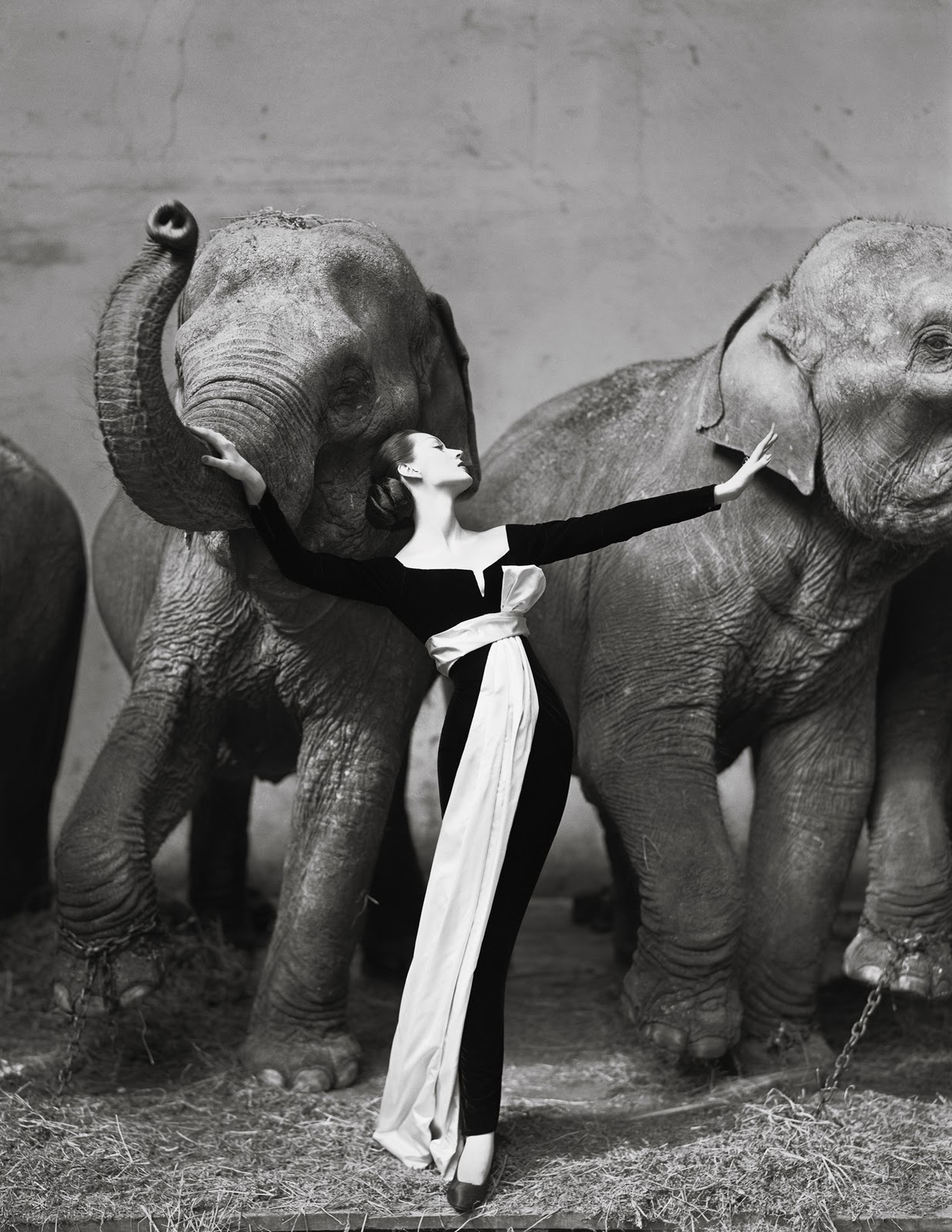 From Winthrop Sargeant’s 1958 New Yorker profile of a young Richard Avedon, who used his camera to reimagine the fashion photograph, which lacked blithe spirit before he enlivened the scene:
From Winthrop Sargeant’s 1958 New Yorker profile of a young Richard Avedon, who used his camera to reimagine the fashion photograph, which lacked blithe spirit before he enlivened the scene:
About twelve years ago, this approach to fashion photography began to be subtly undermined by a sprightly and ingenious photographer for Harper’s Bazaar named Richard Avedon. As far as he was concerned, the statues and mummies went out the window. The model became pretty, rather than austerely aloof. She laughed, danced, skated, gambolled among herds of elephants, sang in the rain, ran breathlessly down the Champs-Elysées, smiled and sipped cognac at café tables, and otherwise gave evidence of being human. Whether she thereby sold more clothes is open to question. But the new trend certainly brightened the page of Harper’s Bazaar, and Avedon was widely conceded to have reached a previously unattained artistic level in fashion photography. A good deal of this accomplishment can be attributed to his imagination and resourcefulness in handling a camera, but some of it undoubtedly stems from the fact that his primary interest is not in fashion but in women.
The Avedon photograph—or, more broadly, the Avedon photographic style—has by now become a lively contribution to the visual poetry of sophisticated urban life. Nearly everybody is familiar with it, for it has long since overflowed the pages of Harper’s Bazaar and influenced the advertising in most of the slick-paper periodicals. It has been imitated by other photographers, but the imitations have seldom approached the animation of the originals; in any case, as soon as the imitators have mastered at least the surface elements of one of Avedon’s innovations, he has always popped up with some entirely new departure, for he has never been one to stand still. The world he depicts is an artificial one; his polished and rather romantic art flatly contradicts the bromide that the camera never lies. Avedon’s camera unquestionably lies, but it does so in such a poetic and ingratiating manner that the photographic fiction it produces has become a sort of folklore of the world in which fashionable elegance counts. The characters in this fiction are women of unbelievable beauty and grace, moving about in an environment that exists largely in the imagination. This is a composite of mists, glowing lights, the moods of nocturnal revellers, nostalgic memories of bars and gaming tables and theatres, and such ephemeral minutiae as the feeling of enchantment at the sight of a taxi in the rain whose door is opened to receive a suave and mysterious beauty, or the moment of gaiety when some lovely girl decides to throw dignity aside, or the magical second in which the casual motions of a beautiful woman are observed secretly across a restaurant table—all fragments of a metropolitan fairyland, glimpsed by ordinary mortals only at times of heightened illusion.•
_______________________________
In 1999, Avedon is interviewed by that agreeable robot Charlie Rose.
Tags: Richard Avedon, Winthrop Sargeant
The aura of the American West was created and commodified long before there was a Hollywood, as traveling stage shows brought an appealing version of gunslinging to the masses. From Rob Walker’s 2007 Sunday Times Magazine article about how Buffalo Bill Cody packaged himself for the millions:
“While still a scout for the United States Army, Cody managed to hire himself out as a sort of celebrity hunting guide for well-to-do visitors to the American West. In 1869, when he was about 25, he impressed a writer calling himself Ned Buntline, who began a series of dime novels starring Buffalo Bill. These inspired a play, with Cody himself in the lead role. For the next several years, Cody switched off between actual scouting work in campaigns against Plains Indians — and appearing in plays with names like Scouts of the Plains.
But the great branding event of his career came in 1876, in the wake of George Custer’s disastrous defeat by Sioux Indians at Little Big Horn. Weeks later, Cody’s regiment engaged in a battle against a group of Cheyenne Indians, and Cody — there’s some disagreement on this — apparently killed one, obtaining what he pronounced ‘the first scalp for Custer.’ That fall, Cody starred in the play based on the incident. And by 1883, he and a couple of key collaborators — notably Nate Salsbury, a manager with wonderful showbiz instincts — had invented a show that ‘provided the template . . . for the early film western,’ Joy S. Kasson argues in her 2000 book Buffalo Bill’s Wild West: Celebrity, Memory and Popular History. In the process, she writes, his Wild West ‘became America’s Wild West.’ Indeed, thanks to Salsbury, they actually copyrighted the phrase ‘Wild West’ (after a lengthy legal battle with rivals).
Live animals and blazing guns made the show more of a spectacle than a mere stage play. But a loose narrative and the vaguely educational content made it more respectable than a circus or a medicine show, and Salsbury kept gambling and drinking off the premises to attract the family demographic. At its height, the show included the sharpshooting of Annie Oakley, dramatic re-enactments of an Indian attack on the Deadwood stagecoach and a version of Little Big Horn. The organizers managed to include many actual Native Americans in the cast, including the Sioux chief Sitting Bull himself for part of its 1885 season.
Still, the authenticity was always balanced against affirmation: Cody’s arrival on the scene in the immediate aftermath of the re-enacted version of Little Big Horn converted a debacle into what felt like a victory. ‘It’s not really wild — that’s why it can be entertaining,’ Kasson, a professor of American studies at the University of North Carolina, Chapel Hill, told me. ‘That’s where it leads to Hollywood: the idea that you can give people the feeling of danger, but it’s got to be basically tame.’ In several tours of Europe, the general theme of civilization triumphing over savagery went over well. (Indeed, Kasson cites the historian Richard White’s point that the Wild West shows essentially recast encroaching settlers as victims.) By the time Frederick Jackson Turner momentously declared that ‘the frontier has gone’ at the Columbian Exposition in 1893, Buffalo Bill’s Wild West was in the midst of a monthslong stint right across the street; it was seen by an estimated six million people.”
••••••••••
Edison captured the pageantry of the Buffalo Bill’s Wild West Show parade:
Another Buffalo Bill Cody post:
Tags: Buffalo Bill Cody, Rob Walker

